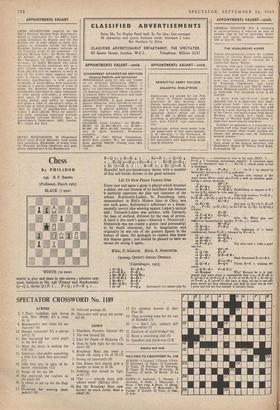Chess
(Probletnist, March 1965) BLACK (7 men) WHITE (io men) WHITE to play and mate in two moves ; solution next
' week. Solution to No. 248 (Fenner and Stephenson):
Q-Q 2, threat Q X P. z PXQ; 2 P-K 3. . B-Q .5 ; 2 R-K 4. I . . . Kt-B 5; 2 Q-Q 4.
. Kt (Q 3)-B 4 ; 2 Kt-R 5. .. Kt (R 3)-B 4 ; 2 Kt (7)-K 6. i . '. ;R-K 5; 2 Kt (5)-K 6. Beautiful half-pin/interference theme with a number of fine self-blocks thrown in for good measure. • LET US Now PRAISE FAMOUS MBN
Every now and again a game is plhyed which becomes a classic, not just because of its excellence but because
• it perfectly expresses the Play and character of the winner. Rubinstein-Lasker, St. Petersburg, .1909, immortalised in Reti's Modern Ideas in Chess, was one such game, Rubinstein's adherence to a funda- mentally correct idea winning against Lgoker's tactical skill ; Tarrasch-Laker was another, with Tarrasch, - the man of method, defeated by 'the man of genius. A third is this week's game-Samisch v. Nimzovich ; Nimzovich was too cranky a player (and personality) to be world champion, but in imagination and originality he was one of the greatest figures in the history of chess. No apologies to readers who know this famous game; you should be pleased to have an excuse for seeing it again.
White, P. Sictrusai. Black, A. NIMZOVICH.
Opening, QUEEN'S INDIAN DEFENCE. (Copenhagen, 1923)
Kt-K 83 P-K 3
ISIgt Kt 3 a B-K 2
0-0 P-Q
a IS 4 / Ppct
3 •Kt- 83
4 P.-4C Kt 3 g B-Kt 2 6 Kt--Q B 3
7 0-0 Introduced into master play by Nimzovicn, tr.interesting to read in the 1965 MCO: '7 . . .
P-9 4 P ecotning, increasingly popular'. I( preserves more scope for nianceuvre than 7 . . . Kr'-K-5 which tends to lead to exchanges. ,8 K€-Kg , P-B ; . . . r (as played by Botwinnik) threatemng P X P. is preferable. P x . . Because now, instead of this timid- move% White could plav,P-K 4 with an excellent game, having a central adventilge.
BP x P • • B-B 4 P--Q R 3 xi R-B • P01 Kt 4 Establishing an outpost of B 5 for his Q Kt, should -- uld he later want it.
12 Q-Kt 3? . . .This leads nowhere. P-K R 3,
P-K Kt 4, 13-Kt 3 and P-I3'4 is his beet plan. • •
12 . fa-•-B .
i3KSXKg. . . And here x3' Kt xQ P, Kt xP (t3 . . . P x Kt . Kt x Kt); ta Kt x 13 do, Q x Kt; 15 Q-Q 3 is better.
B x Kt
R 3 Q-Q 2,
• 1V-R . . After this White gets into difficulties extraordinarily quickly.' P-Kt 4 is correct. .15 . . ,• • Kt-R41 16 Br-Q 2 P-3 ,` • • •
17 Q-Q r ." . The beginning of -a faulty combination; better P-K2,3 followed by Kt-K 2. 17 .
re Kt-Kt r K€, rg R-1-Kt r 11--Q 3 '
20. P-K 41? • The idea-and it looks a good one, but... 'BP* PI 2r §x Kt R x P 22 -Kt g Q R-K B r
23 -R r Black threatened R (r)-B 6. R (4-8 4 24 Q-K 3 .B-Q 6 Threat 4-1( 7, winning the :preen. . • Q R-K r P-K R 31 26 Resigns , . . Why? Because he is in rus- zvranig! Any piece move is immediately fatal (e.g., 26 K-R 2, R (4)-B 6 or 26 B-Q B e B X Kt or 26 R-Q B r, R-K 7), 26 P.••-Kt. 4, R (4)-B 61 418'0 loses at once, his one or two sate pawn moves are soon exhausted, and then he must lose alt least
a piece and still not free himself. A fantastic finish. •


































 Previous page
Previous page